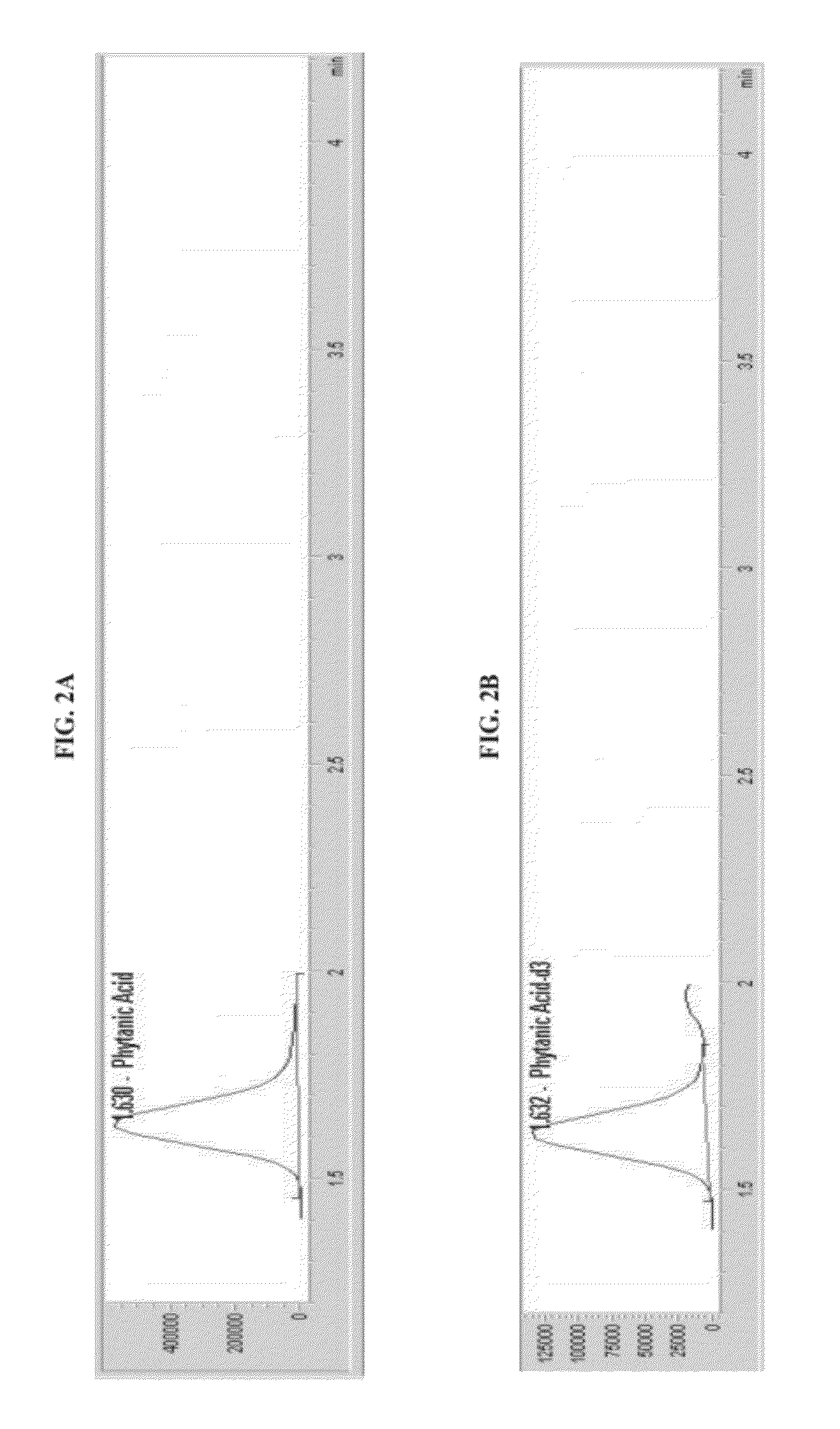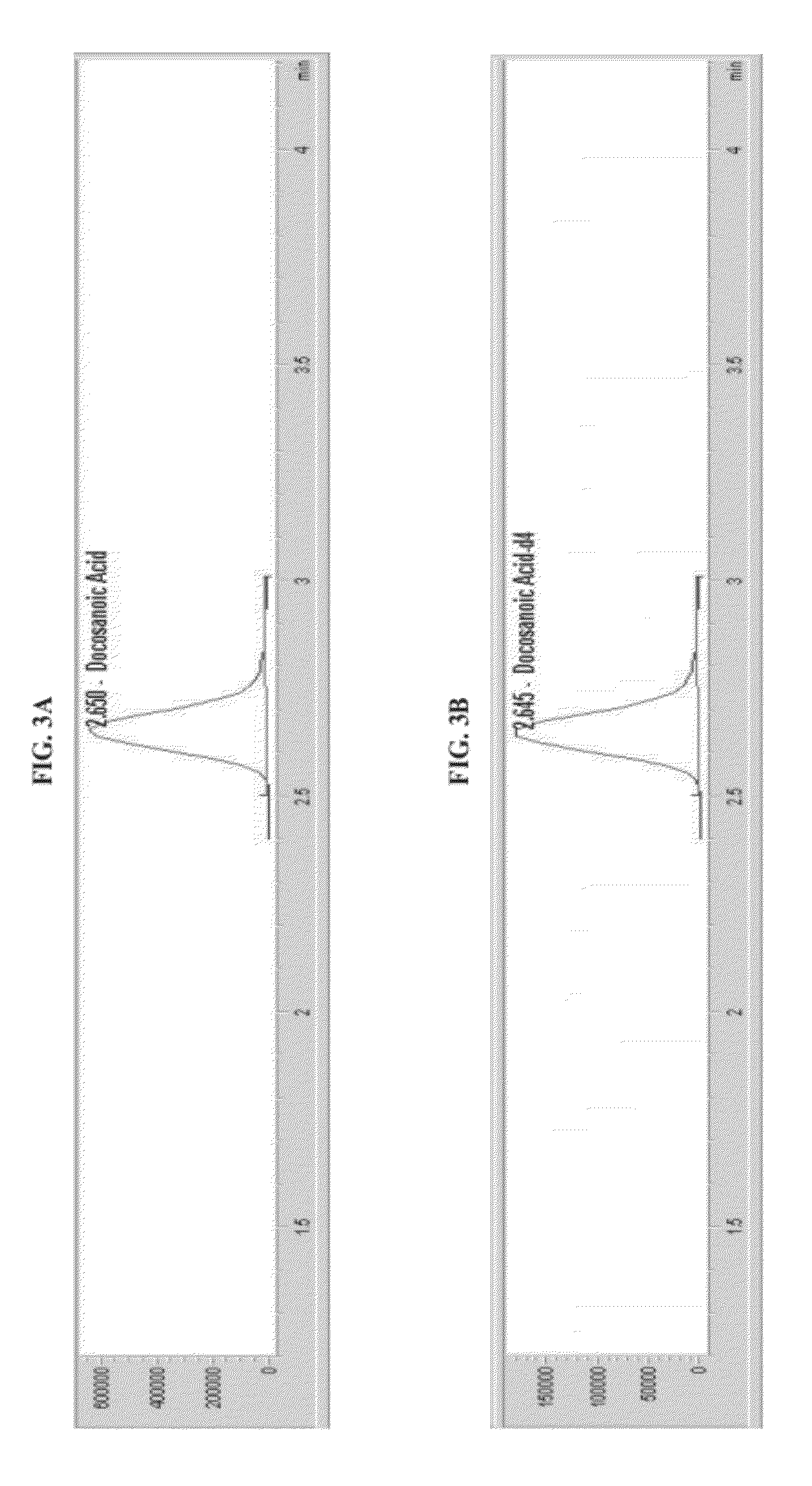Mass spectrometric determination of fatty acids
a mass spectrometric and fatty acid technology, applied in particle spectrometer methods, instrumentation, particle separator tube details, etc., to achieve the effect of improving solvent removal, saving significant time and expense, and less susceptible to dissociation
- Summary
- Abstract
- Description
- Claims
- Application Information
AI Technical Summary
Benefits of technology
Problems solved by technology
Method used
Image
Examples
example 1
Hydrolysis of Fatty Acid Esters and Liquid-Liquid Extraction
[0097]The following hydrolysis and liquid-liquid extraction techniques were conducted on controls, standards, and patient serum samples to prepare samples for mass spectrometric analysis. Plasma samples were also tested with similar results (not shown).
[0098]First, 100 μL of an isotopically labeled VLCFA-2H3 and / or BCFA-2H3 internal standard mixture was mixed with 200 μL aliquots of each standard, control, and patient sample. 200 μL of 1.0M NaOH were added to the sample mixture and the NaOH-treated mixture was heated at temperatures between about 120° C. and 125° C. for about 60 minutes. The mixtures were then removed and allowed to cool for about 5 minutes.
[0099]After cooling, 400 μL of 5M HCl was added to each cooled sample mixture and vortexed briefly. The sample mixture was then re-heated at temperatures between about 120° C. and 125° C. for about 75 minutes. After incubation was complete, the mixtures were again allowe...
example 2
Purification of VLCFA and / or BCFA with Liquid Chromatography
[0102]Sample injection was performed with an Agilent Technologies G1367B Autosampler.
[0103]The autosampler system automatically injected an aliquot of the above prepared reconstituted samples into a Thermo Scientific BDS Hypersil C18 HPLC column (3 μm particle size, 100×2.1 mm, from Thermo Scientific). An HPLC gradient was applied to the analytical column, to separate VLCFA and BCFA from other components in the sample. Mobile phase A was 20 mM ammonium acetate and mobile phase B was 82% acetonitrile in methanol. The HPLC gradient started with an 82% solvent B which was ramped to 90% in approximately 1 minute, then ramped up to 95% for another minute, and held at that percentage for approximately 36 seconds, before being ramped back down to 90% over the next one minute and 18 seconds, and then down to 82% over the next 24 seconds. Column flow rate during solvent application was about 0.85 mL / min. Pristanic acid, phytanic aci...
example 4
Detection and Quantitation of VLCFA and / or BCFA by MS
[0104]MS was performed on the above eluted samples using an Agilent 6130 Single Quadrupole Mass Spectrometer. Liquid solvent / analyte exiting the analytical column flowed to the ionization interface of the MS / MS analyzer. The solvent / analyte mixture was converted to vapor in the tubing of the interface. Analytes in the nebulized solvent were ionized by APCI.
[0105]Ions passed to the quadrupole mass selector (Q1), which selected pristanic acid, phytanic acid, docosanoic acid, tetracosanoic acid, and hexacosanoic acid ions with mass-to-charge ratios (m / z) of 297.3±0.5, 311.2±0.5, 339.3±0.5, 367.3±0.5, and 395.4±0.5, respectively. The selected ions then traveled to a detector for counting. Mass spectrometer settings used for this Example are shown in Table 1. Simultaneously, the same process using isotope dilution mass spectrometry was carried out with internal standards: pristanic acid-2H3, phytanic acid-2H3, docosanoic acid-2H3, tetr...
PUM
| Property | Measurement | Unit |
|---|---|---|
| particle diameter | aaaaa | aaaaa |
| diameter | aaaaa | aaaaa |
| temperature | aaaaa | aaaaa |
Abstract
Description
Claims
Application Information
 Login to View More
Login to View More - R&D
- Intellectual Property
- Life Sciences
- Materials
- Tech Scout
- Unparalleled Data Quality
- Higher Quality Content
- 60% Fewer Hallucinations
Browse by: Latest US Patents, China's latest patents, Technical Efficacy Thesaurus, Application Domain, Technology Topic, Popular Technical Reports.
© 2025 PatSnap. All rights reserved.Legal|Privacy policy|Modern Slavery Act Transparency Statement|Sitemap|About US| Contact US: help@patsnap.com



